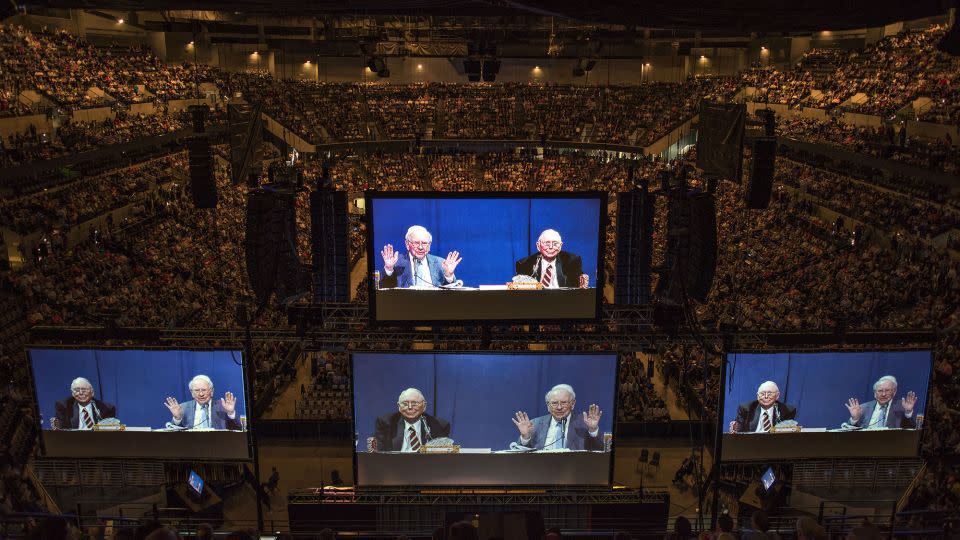How investing $100 in Berkshire Hathaway when Charlie Munger joined would now be worth nearly $400,000
A version of this story first appeared in CNN Business’ Before the Bell newsletter. Not a subscriber? You can sign up right here. You can listen to an audio version of the newsletter by clicking the same link.
Billionaire investor Charlie Munger was affectionately called the “abominable no-man” by close friend and confidant Warren Buffett. That nickname was apt in more ways than one.
Munger, a billionaire investor and vice chairman of Buffett’s investment firm Berkshire Hathaway, died Tuesday morning at 99 years old.
Buffett, who gave Munger his nickname for often checking his enthusiasm, said Tuesday that the company “could not have been built to its present status without Charlie’s inspiration, wisdom and participation.”
Munger was most well-known as Buffett’s right-hand man and one-half of the formidable duo that led the company’s legendary annual shareholder meetings in Omaha. But he was also a force of his own.
If someone had invested $100 in Berkshire Hathaway in 1978, the year Munger joined the firm, the investment would be worth nearly $400,000 as of Tuesday’s close – leaps and bounds above the $16,527 that $100 invested in the benchmark S&P 500 that same year would have yielded, according to Bespoke Investment Group data. (Berkshire Hathaway shares, which didn’t have different classes then, ended 1977 at $138 a share.)
So, what was Munger’s investment approach? Munger had an at-times abrupt and blunt nature that was well-documented even from his days at Harvard Law School. “Actually, Charlie was just in a hurry,” notes Michael Broggie in Poor Charlie’s Almanack – but his approach to assessing whether a company deserved his investment was a lengthy and exhaustive process.
Munger bet big, long and selectively using a thorough screening process. He sought out easy-to-understand businesses that could flourish in any market environment, according to the book. He vetted investment candidates using “multiple mental models,” which, put simply, consisted of collecting and analyzing information about the internal and external environments in which the companies operated.
Once Munger concluded a business was worth his hard-earned cash, he would make a large bet and leave it alone – “sit-on-your-a** investing,” as he called it. “You’re paying less to brokers, you’re listening to less nonsense, and if it works, the tax system gives you an extra one, two, or three percentage points per annum,” Munger said.

His approach, together with Buffett’s, paid off in spades. Berkshire outperformed the S&P 500 during 31 of the 46 years Munger was at the company, according to Bespoke.
Some of his decisions didn’t require such meticulous analysis – Munger had a deep yet uncomplicated dislike of digital assets.
“I detested it the moment it was raised, and the more popular it got, the more I hated it,” Munger said at The Daily Journal’s annual meeting in 2018. “Who would want their children to grow up buying things like Bitcoin?”
The price of the ‘12 Days of Christmas’ just hit a record high
Your True Love’s lavish — and stunningly bird-laden — holiday gift-giving ritual is more expensive than ever before.
But at least this time around, inflation’s not as piping hot, reports my colleague Alicia Wallace.
The cost of the dozen gifts outlined in the “Twelve Days of Christmas” song rang in at an all-time high of $46,729.86 this year, according to PNC Financial Services’ 2023 Christmas Price Index, a lighthearted seasonal report that measures the average change in prices for the solo partridge, two turtle doves, seven swans, 12 drummers and other presents in the classic Christmas carol.
The Christmas Price Index, now in its 40th year, is a tongue-in-cheek take on the Bureau of Labor Statistics’ Consumer Price Index and is meant to highlight market changes over time while educating consumers about the economy.
That 2023 price tag is up 2.7% from a year ago, representing a far more palatable increase than the eye-popping 10.5% leap seen this time last year.
The holiday index also is running a touch cooler than its traditional counterpart, the Consumer Price Index, which was up 3.2% for the 12 months ended in October and 7.7% this time last year.
Something to feel (turtle) dovish about: Even festive and unofficial inflation gauges appear to be feeling the effects of one of the most aggressive interest-rate hiking cycles in US history.
Rite Aid is closing another 30 stores
Rite Aid is closing another roughly 30 locations across the US in addition to the 100 the bankrupt chain announced last month as part of its restructuring efforts.
The latest round of closures was revealed in a bankruptcy court filing with 31 stores closing in a dozen states, including seven in California, four in Pennsylvania, three locations each in Ohio, Virginia and Washington and two each in Michigan, New Jersey, Oregon and New York. The remaining stores are one each in Connecticut, Maryland and Nevada.
Rite Aid will have about 2,000 stores remaining when both rounds of closures are complete, reports my colleague Jordan Valinsky. The company didn’t immediately reply to CNN’s request for comment.
The writing has been on the wall for some time for Rite Aid, the third-biggest standalone pharmacy chain in the US, as the entire drug store retail sector struggles to compete with Amazon and big-box chains like Walmart, Target and Costco moving deeper into the space and offering more customer-friendly alternatives to the nationwide pharmacy chains.
Compounding its problems were legal troubles stemming from accusations of filing unlawful opioid prescriptions for customers.
For more CNN news and newsletters create an account at CNN.com

 Yahoo Finance
Yahoo Finance 